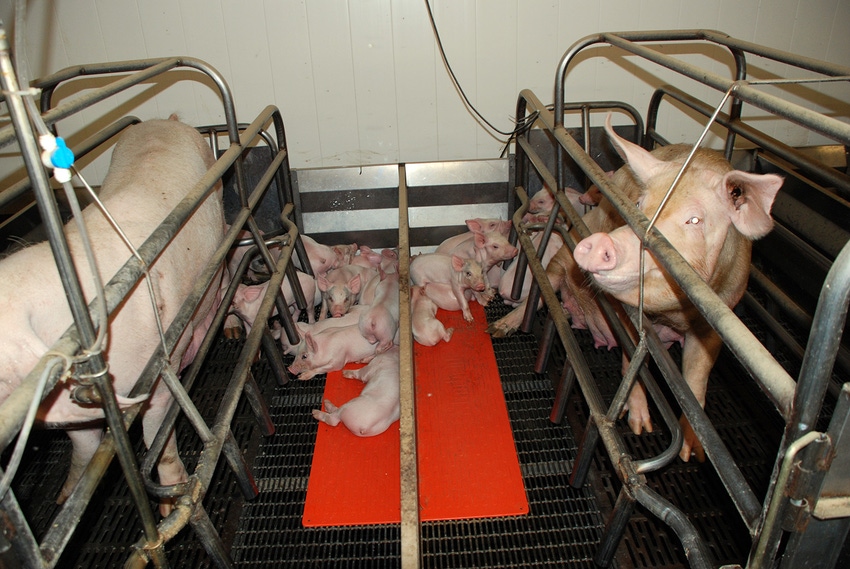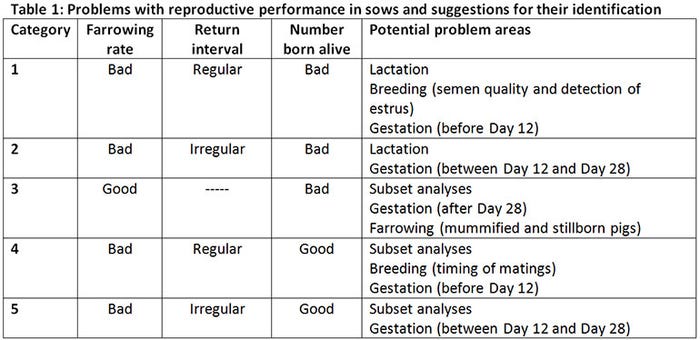3 production variables help pinpoint reproductive management issues
When reproductive problems occur, it can be useful to group farms into categories based on farrowing rate, number of pigs born alive and return intervals in order to determine possible causes.
March 28, 2017

By W.L. Flowers, North Carolina State University Department of Animal Science
Most modern record keeping systems provide swine producers with the following: a) farrowing rate; b) number of pigs born alive; and c) return intervals of non-pregnant females.
When reproductive problems occur, it can be useful to group farms into categories based on these three production variables in order to determine possible causes. Table 1 contains five of the most common of these combinations and the corresponding management areas where problems might exist.

Category 1: Poor farrowing rate with regular return intervals and poor number born alive
Poor farrowing rate and number born alive coupled with regular return intervals can be caused by one or more of the following: a) poor fertilization rates; b) high embryonic mortality during the first two weeks of pregnancy; and c) low ovulation rates.
In sows that did not conceive, there were not five viable embryos present on Day 12 of pregnancy. These sows never received the first pregnancy signal on Day 12, so pregnancy was terminated and they returned to estrus at regular intervals. Physiologically, it is similar to never being bred. From a management perspective, the time interval to scrutinize in search of potential problems is from farrowing through the first two weeks post-breeding. The most common causes of fertilization failure are poor semen quality and poor breeding management.
Consequently, microscopic evaluations of semen should be performed along with a thorough review of estrous detection procedures and breeding regimens. Low ovulation rates and high embryonic mortality are often associated with short lactation lengths or poor feed intake during lactation.
Finally, the presence of any social, physical or environmental stresses during the first two weeks post-breeding should be investigated. Common ones include rough handling during movement of animals, high ambient temperatures and competition for food and space among sows in pens.
Category 2: Poor farrowing rate with irregular return intervals and poor number born alive
This category is similar to the first one described with one important exception: sows that do not farrow return to estrus at irregular intervals. Physiologically, this indicates that there were sufficient numbers of embryos to produce the first pregnancy signal at Day 12, but not for the second one which occurs sometime between Day 17 and Day 28. This is why the return intervals of sows are greater than 28 days. The sows were pregnant during the first two weeks after breeding, but not during weeks three or four.
Low ovulation rates and high embryonic mortality between Day 12 and Day 28 are most likely candidates for creating this situation. Conversely, it is unlikely that fertilization failure is a contributing factor. If it was, then embryonic numbers would be low before Day 12, not after, and non-pregnant animals would be expected to exhibit regular returns to estrus (as in situation 1).
Consequently, management practices during lactation and during the third and fourth weeks of pregnancy need to be examined. On many operations, sows are often moved from the breeding area to gestation barns by 30 days post-breeding. If sows are moved during the third or fourth week of pregnancy, then the manner in which they are moved should be examined closely since their movement corresponds with a potential cause of poor performance in this situation – high embryonic mortality after Day 12.
Category 3: Good farrowing rate and poor number born alive
From a physiological perspective, when farrowing rate is good, this means that there were adequate numbers of embryos present on Day 12 and between Day 17 and Day 28 for both pregnancy signals to occur. Consequently, a logical assumption is that management during lactation, rebreeding and the first month of pregnancy probably is good. The low number of pigs born alive most likely results from things that cause a high incidence of embryonic or fetal death after Day 28. This is a situation in which numbers of mummified fetuses and numbers of stillborn pigs should be examined. If the number of mummified fetuses is high, then the problem most likely occurred after Day 50 of gestation.
In contrast, if the number of stillborn pigs is high, then the problem probably is during the last week of pregnancy or during farrowing itself.
As discussed in the previous section, subset analyses can also be helpful in “trouble-shooting” situations in which farrowing rates are good, but litter size is not.
Category 4: Poor farrowing rates with regular returns to estrus and good number of pigs born alive
Whenever numbers of pigs born alive is good and farrowing rate is bad, then the problem almost always is related to poor management in a group or subset of sows. Obviously, in the sows that did farrow, everything from a physiological standpoint worked well because they had large numbers of pigs. It is the sows that did not farrow that are causing the low farrowing rate.
Consequently, the length of time it takes non-pregnant sows to return to estrus is a key piece of information. In the present situation in which sows show regular returns, the problem involves inadequate breeding regimens or high embryonic mortality prior during the first two weeks after breeding. Causes of high embryonic mortality during this period have been discussed previously and should be investigated.
Category 5: Poor farrowing rate with irregular returns to estrus and good number born alive
The observation that non-pregnant sows return to estrus by 28 days or longer after being bred indicates that the first pregnancy signal on Day 12 occurred without any problems. In other words, they were pregnant on Day 12.
As a result, pregnancy was terminated in a subset of animals some time after the first two weeks. Possible causes of high embryonic mortality between Day 12 and Day 28 should be examined. In addition, it is possible that a high incidence of fetal death later in pregnancy could also be involved. If this were the case, then the proportion of sows diagnosed as pseudopregnant or “not-in-pig” should also increase. Once the second pregnancy signal occurs, sows usually maintain pregnancy to term unless something causes them to abort. If they lose all their viable fetuses after Day 28, then they still act physiologically as if they are pregnant.
Situations that cause high levels of fetal death after Day 28 of pregnancy fortunately are rare. Consumption of mycotoxins such as zearalenone and several reproductive diseases have been linked to high incidences of fetal death and pseudopregnancy in sows. These situations can be identified with feed and serological analyses, respectively.
You May Also Like



